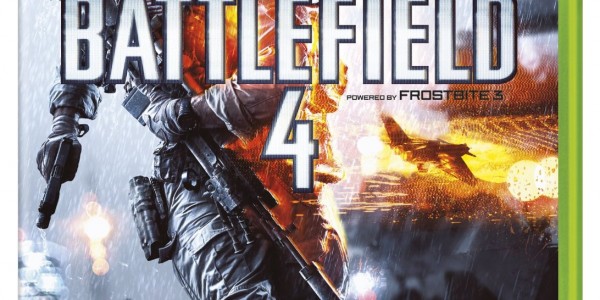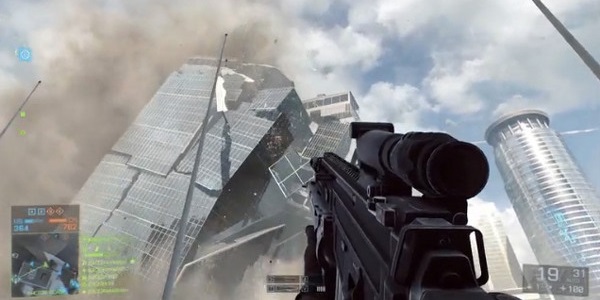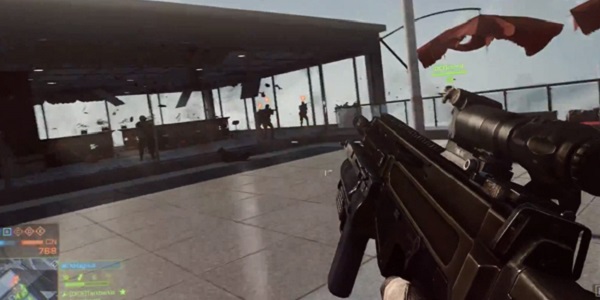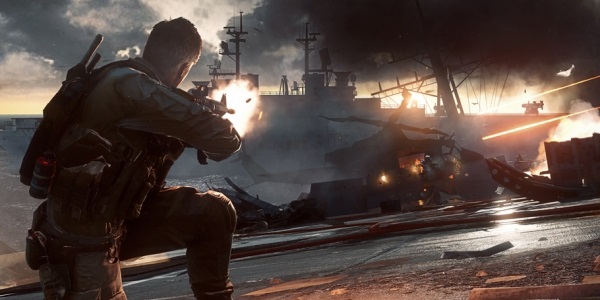It’s become abundantly clear over recent years that modern or near-future military shooters of the first-person variety don’t place a high emphasis on story, especially when compared to their multiplayer components. In Battlefield 4, this trend hasn’t been bucked, only reinforced. But despite what I found to be yet another campaign lacking strong narrative, EA and DICE’s latest entry to the series takes its already addictive online action to new, awe-inspiring heights.
Battlefield has been able to snag gamers over the years primarily due to the destructive nature of the game’s environments thanks to the Frostbite engine. In Battlefield 4, that’s taken to a whole new level via what DICE and EA call “levolutions”, which in English means large-scale destruction of major structures within the level that permanently change the map for a match’s remaining duration. While these major shakeups didn’t happen often in my play sessions, triggering them did hold strategic significance and were flat-out jaw dropping whenever a team decided to cause one.
The tactical options these events provide left me baffled that players weren’t trying to trigger them more often. They allow the losing team the ability to alter one or more of the map’s crucial control points on the larger game modes such as conquest. This destruction then forces the opposing team to regroup and adapt to the evolving situation, creating a second chance and making each online contest more competitive.
Another aspect of the Battlefield franchise that these “levolutions” showcase and elevate is its visual presentation. Already known for being one of the highest-detailed, most visually impressive series in gaming, watching a skyscraper collapse or ship crash into an island during an intense storm with no drop in frame rate proved to me that Battlefield 4 has upped the ante once again. Though there are some texture pop-in issues at the start of matches on current-gen systems, the locales still remained among the best I’ve seen on the consoles.
Of course the most important things I kept account for visually were the enemies I locked into my weapons’ sights as I fired away in pursuit of victory. It’s good to have discovered then that Battlefield 4 doesn’t do much to shake up or change what was such a successful combat and leveling system in Battlefield 3. The previous entry’s same four classes return (Assault, Engineer, Support, Recon) and serve the same roles with some balancing tweaks. For instance, sniping as a recon class was a tad more challenging this time around, which is a positive change, as some players in Battlefield 3 had become accustomed to its perks and were able to rack up a large amount of kills.
Luckily, however, most of what Battlefield 4 had me focus on was contributing to winning in various ways or leveling up my online persona for future unlocks instead of pure frags. This is the beauty of Battlefield’s combat to me: that one can be just as helpful healing teammates or repairing vehicles as those mowing down enemy combatants with headshots. The only time kills are ever the focus are in the deathmatch modes, for obvious reasons, which only make up a portion of the game’s multiplayer suite.
Aside from Deathmatch and Conquest modes, the game features other match types that add strong competitive diversity. Obliteration was perhaps the standout for me among all the others, as it’s a new mode where both teams battle over control of a bomb in order to blow up enemy targets. Whichever team destroys all enemy targets first wins. This style of play highlights Battlefield 4’s love for destructive environments, and still brings something fresh to the table.
The game’s additional new mode, Diffuse, tasks one team with defending targets while another tries to blow them to bits. The intriguing aspects are that players only get one life and this is an infantry-only mode. It’s a nice change-up for those who may grow weary of the traditional Battlefield combat and want some close-quarters, high-intensity engagements. Other modes that offer their own interesting twist on multiplayer competition include Domination, Rush, and squad-scaled versions of certain game types.
For all the excellence that comes with Battlefield 4’s multiplayer, its single-player campaign is an average and rather forgettable experience. Yes, there were plenty of satisfying action sequences and set pieces that left me impressed, but it’s in the mode’s actual narrative where nothing of significant note occurs. It’s yet another tale of an elite squad of soldiers getting caught up in a struggle that could escalate into large-scale war if they don’t stop it. This time the cause comes from civil unrest and a military coup in China, with Russian support, where the actions of a few US soldiers involved could implicate the nation and bring about some serious international conflict.
In the end, it amounted to a story of top secret tactical missions, evoking memories of the recently departed Tom Clancy, as opposed to that of the everyman-at-war journey featured in TV and film from the likes of Tom Hanks, Steven Spielberg, and Oliver Stone. It’s not much of a shock given that this has become the status quo in the genre since Call of Duty 4: Modern Warfare, but it makes one wonder if Battlefield even needs a single-player component anymore if this is the route DICE will continue to go down. Perhaps in the series’ next entry, it should build from the groundwork being laid right now by Titanfall and go multiplayer-only.
Despite its enjoyable-yet-cliché and unimpressive campaign, Battlefield 4 provides gamers with a multiplayer experience that is unmatched thanks to its evolving combat zones fueled by destruction. Its “levolutions” are a sight to behold that made me think with glee what DICE will be able to do with the Frostbite engine when focused entirely on the new generation of ocnsoles. Shooting opposing forces online hasn’t gotten old, even if doing so on your own may finally have.





















